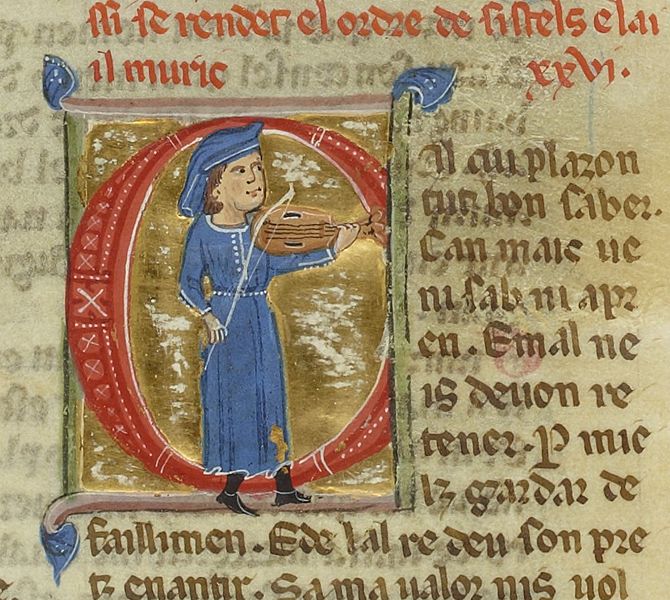By Danièle Cybulskie
http://www.medievalists.net/2015/01/troubadours-part-sad-songs-say-...
Recently, I wrote a little bit about English alliterative poetry, but there is another style of poetry that was even more famous in the Middle Ages: troubadour poetry. I think when most people picture medieval music, they see a travelling minstrel, going from castle to castle to play music and entertain. Troubadours were different from travelling minstrels in that they were poets and instrumentalists who usually remained in the employ of one important person for vast stretches at a time, if not their whole careers. The height of their popularity was in the 12th-13thCenturies, and they wrote songs about people, politics, and religion, but most of all, love. Let’s take five minutes to talk about troubadours.
Generally, people tend to say that the first troubadour was William of Aquitaine (1071 – 1127 CE), Eleanor of Aquitaine’s grandfather. As duke of Aquitaine (and count of Poitiers), William was far from being a travelling minstrel, but was fond of composing songs, especially ones about sex – perhaps not what we might expect from such a powerful nobleman. (For example, one of William’s famous poems was about choosing between two “horses” to get the better ride. You can find this one on page 33 of Anthony Bonner’s book Songs of the Troubadours.) In the south of France, in duchies such as Aquitaine, songs following William’s lyrical conventions began to flourish, and troubadour culture began. Most of these songs were written in the “lenga d’oc”, a language spoken in southern France that (according to Meg Bogin in The Women Troubadours
) was more like modern Spanish or Portuguese than modern French. (Needless to say, that language has since been displaced by modern French.) This style of song and lyric quickly spread beyond southern France, however, influencing culture in Italy, Spain, and even England, thanks in large part to Eleanor of Aquitaine’s marriage to Henry II.
Although troubadours were certainly not limited to love songs, they are credited with being the instigators of the “courtly love” tradition – the idea of a love that is often unrequited or hidden, frequently adulterous, and very dramatic. Bonner adds that troubadour poetry in this vein also has a singer who must “make himself worthy” of his lady’s love, and that the lady herself often has a pseudonym (p.23). William of Aquitaine addresses a song to a “Bon Vezi” or “Good Neighbour” (p.39), for instance. Using a pseudonym protected the lady who was the subject of these songs, if she was a real one (instead of a fictional ideal), and gave the assembled company the fun of speculating who she might be. Often, the troubadour is suffering for lack of affection from a lady he knows he cannot have, and sometimes he is very explicit about it. For example, Marcabru asks a starling to tell his lady,
that I will die
unless I know
whether she
sleeps dressed or in the nude. (Bonner, p.57)
Clearly, this isn’t just a friendly kind of love, but a torturous, lusty longing for a union which is forever out of reach. One of the most famous troubadours, Bernart de Ventadorn, writes,
O love which I so covet,
well-formed body, thin and smooth,
fresh skin and high color
which God fashioned with His hands,
I have always wanted you,
for nothing else so pleases me,
no other love so tempts me.
O wise, gentle lady, may He
who fashioned you so beautifully,
grant me that joy which I await. (Bonner, p.87)
Troubadour songs like these were performed in court, to the delight of an audience of both men and women, demonstrating that the Middle Ages was not quite as pious and straight-laced as some might believe. These artists came from all ranks of society (unlike William, Bernart de Ventadorn was said to be the “son of a servant”, Bonner p.82), and their racy songs were widely loved and accepted, which is part of the reason they have survived.
Not all troubadour poetry was lusty, not all of it was complimentary, and not all of it was written by men. Next week, we’ll take five minutes to look at the work of the female troubadours, or trobairitz (Bogin, p.63), but this week, I’ll leave you with a particularly lovely lyric by Bernart de Ventadorn:
May she have the courage
to have me come one night
there where she undresses
and make me a necklace of her arms. (Bonner, p.84)
Five minutes with troubadour poetry is five beautiful minutes, indeed. You can find more troubadour poetry (including Bernart’s and William’s – although, sadly, not the horse one) and brief biographies by following this link. (Handy tip: there, William is called Guillaume de Poitiers.)
You can follow Danièle Cybulskie on Twitter @5MinMedievalist


















Pentru a putea adăuga comentarii trebuie să fii membru al altmarius !
Alătură-te reţelei altmarius